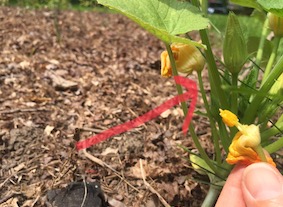-
Phone
+86- 111****
-
Address
Boluo county dragon Lotus Lake Village Town Industrial Park, China
-
E-mail
Hand Pollinating Squash, Zucchini and Cucumber Flowers - Planters Place

Hand pollinating squash or zucchini or cucumbers in order to get a crop might seem like a lot of work. But in a few instances, it may be your only chance to produce a squash crop. In a previous Just Veggies blog post I explained the reasons why baby cucurbit fruits—things like summer squash, zucchini and cucumbers—may turn yellow or brown and then rot off the stem. In a nutshell, it’s due to incomplete or total lack of pollination. No pollen to fertilize the female flower, then no chance for the baby fruit to mature. Why does this happen? Could be few or no honeybees to do the pollinating for you. Could be the weather. Could be that your squash foliage is so lush that the bees can’t find their way to the flowers. It happens.
My first few pinky-sized cucurbits tend to rot and fall off. I attribute it to seasonal cool and cloudy weather, conditions in which honeybees don’t like to fly. The weather warms, everything sorts itself out and I eventually harvest bushels of squash, zucchini and cucumbers. If, however, my lack of pollination continued, I would find the need for hand pollinating the female cucurbit flowers; that is, to transfer pollen from a male flower to the stigma in a female flower.
Identifying Male and Female Flowers
You have to know which flower is male and which is female in order to pollinate by hand. Here’s the simple two-part assessment:
- Look at the flower and the small stalk that connects it to the rest of the plant. If it is a simple and straight stalk, it’s a male flower. If it looks like a teeny tiny squash or cucumber is forming from the stalk, then it’s a female flower.
- Now look inside the flower for confirmation. If you touch the flower part—the anther—inside and your finger comes away with pollen, it’s a male flower. If you touch the flower part—the stigma—and it’s not coated with pollen and maybe a little sticky, then it’s a female flower.
Pairing Pollen with Stigma
Again, squash plants (and a whole mess of other veggies) need pollen to be in contact with the female flower’s stigma in order to produce fruit. If honeybees aren’t around to do it, you yourself are an acceptable substitute. Snip the pollen-filled anther from the male squash or cucumber flower and gently touch it to the top of the female flower’s stigma a few times.
This method works well for squash and zucchini, but cucumber flowers are way, way smaller. Snipping the male’s anther off is darn near impossible because it’s so short. Instead, use a Q-Tip or paint brush, swiping it across the male’s anther to pick up pollen, then swiping it across the female’s stigma to complete the transfer.
Whichever method you use, you’ll notice the base of the female flower start to swell within days. Look at that—you’re giving birth to a squash.
p.s. Colleague Nina Koziol wrote a feature item with all the tips for growing summer squash. Give it a read HERE.
